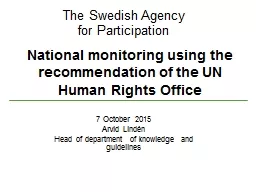PPT-National monitoring using the recommendation of the UN Huma
Author : kittie-lecroy | Published Date : 2016-08-04
7 October 2015 Arvid Lindén Head of department of k nowledge and guidelines The Swedish Agency for Participation National implementation and monitoring
Presentation Embed Code
Download Presentation
Download Presentation The PPT/PDF document "National monitoring using the recommenda..." is the property of its rightful owner. Permission is granted to download and print the materials on this website for personal, non-commercial use only, and to display it on your personal computer provided you do not modify the materials and that you retain all copyright notices contained in the materials. By downloading content from our website, you accept the terms of this agreement.
National monitoring using the recommendation of the UN Huma: Transcript
Download Rules Of Document
"National monitoring using the recommendation of the UN Huma"The content belongs to its owner. You may download and print it for personal use, without modification, and keep all copyright notices. By downloading, you agree to these terms.
Related Documents














